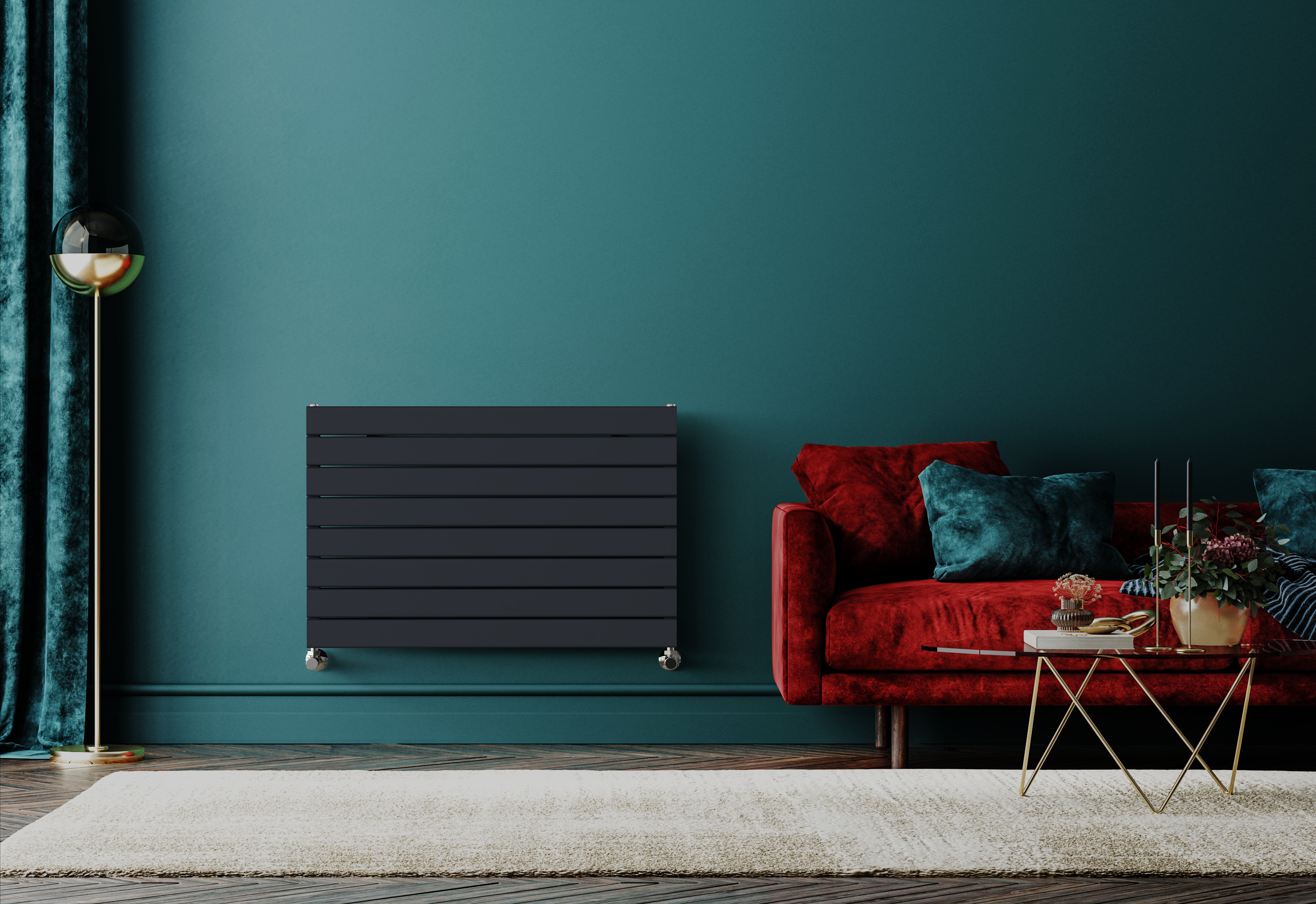How To Paint Your Radiator

Whilst we have a huge range of coloured designer radiators, you might find that painting your existing radiators is the way to go. If your radiator is still performing well with no cold spots and has no cold bottom, painting it may be the key to giving it a new lease of life and giving your home a fresh new look. Whether you are seeking a fresh coat of white paint to breathe new life into your older radiators, or looking for a dramatically colourful transformation this guide will tell you everything you need to know and do to successfully paint your radiators yourself. With a new coat of paint your radiator can blend seamlessly into your walls and complement your space effortlessly, or become a bold focal point of any room with a vibrant colour.
There are several ways to paint your radiator which will be detailed below in our handy guide.
What You Need To Paint A Radiator
- A clean radiator – it might be a good idea to remove your radiator so you can paint both the front and back and allow it to dry safely.
- Damp and dry clean microfibre cloths.
- Dust sheets/newspaper to protect your floor whilst painting.
- Sandpaper – medium grit.
- Radiator primer.
- Paint in your chosen colour.
- Paintbrushes – you may need a couple sizes, a large one for most of the painting and a smaller one for tricky spots.
Top Tip: If you are going to paint your radiator pipework too, it is a great idea to have extra cardboard or paper to hand to place between the wall and the radiator, to help you avoid any paint getting onto the wall.
What Kind of Paint Should I Use?
There are several varieties of paint you can use to paint your radiator; each have their own benefits and downfalls. Think carefully about your needs for your radiator and consider each choice before selecting your paint.
- Specialist radiator paint
If you are painting your radiators white, this is the best option. Specialist radiator paint is manufactured to be less likely to yellow over time, like other varieties of paint may do. There is a more limited selection of colours with specialist radiator paint, but for a fresh coat of white, we recommend it.
- Solvent-based paints
Satinwood from Dulux is a great option for a solvent-based paint as there is a huge range of colours to choose from. If you are seeking, bold, vibrant colours then look no further. One thing to note is that you may find the paint smells a little when you first use your radiators after painting. This paint smell will fade in a few days.
- Standard emulsion with a clear overcoat
You can use a standard emulsion paint, after applying primer of course, then use a clear protective radiator overcoat to seal the paint in. This clear overcoat will protect your radiator from scuffs and bumps. If your radiator will be used a lot during winter, you may consider a different type of paint, as emulsion may crack slightly when it is heated for a long period of time.
- Spray Paint
You can use a spray paint to paint your radiator. We recommend you remove your radiator and use your spray paint outside wearing a facemask to avoid inhaling the paint. You could use spray paint in a garage or an empty room, but ensure you cover all floors to protect your space, and keep all windows open to well ventilate the room.
How To Paint Your Radiator
Step 1 – Preparation
Turn off your central heating and open the window in the room your radiator is in. Your radiator must be cold before you paint it. If your radiator is still warm, the paint will not adhere to the surface properly and will be drippy and uneven.
You must ensure the room is well ventilated when you paint the radiator, all windows must be open in the room to ensure good air flow.
Clear the area in the room, hoover as much dust and dirt as possible to avoid anything sticking to the wet paint.
Clean your radiator, using a damp cloth or sponge and a mild soap like washing up liquid, then dry with a clean cloth.
Place your dust sheets or protective newspaper down to cover the floor surrounding your radiator and protect from drips and spills.
Step 2 – Sanding the Radiator
Sanding your radiator will help to roughen the surface, which will make it easier for the paint to adhere to the surface and give a nice, even coat.
Using a medium grit sandpaper, sand your radiator evenly to clear any unwanted surface debris. Pay close attention to rough spots, ensuring they are smoothed out to create a nice even surface for paint to adhere to. Take the time to do this step properly, the smoother your radiator, the better the paint finish will look.
Once all the rough edges and rust marks have been removed, dust your radiator and clean again so it is ready to paint.
Hoover the room and around the radiator again to clear all dust, and use a microfibre cloth that is slightly damp to remove any dust stuck to the radiator.
Step 3 – Priming the Radiator
You will need your radiator primer for this step. Priming the radiator is crucial as it will protect the bare or rusty parts of your radiator and provide a good, solid base for the paint to cling to.
If your radiator does have rust spots, it is a good idea to use an anti-corrosive primer to prevent the rust from getting worse over time.
Apply your primer with a standard paintbrush following the manufacturer’s instructions.
If you are using a metal primer spray, ensure you spray from 6-8 inches away from the radiator to avoid coating too heavily.
Paint or spray in smooth motions up and down the radiator to prevent drips and wet spots from forming.
Check the manufacturer’s instructions on drying times, but leave the radiator to dry for a minimum of 3 hours to completely dry. Your radiator must be dry to the touch and not tacky.
Step 4 – Painting the Radiator
Your radiator will now be primed, dry and ready to paint. Give your radiator one last wipe down to sweep away any dust that has settled.
If you are using a tinned paint, give the tin a good shake before opening and a good mix before you start to use it.
Carefully apply the paint top the surface of the radiator, being careful not to overload your brush. Paint in the same direction as the grooves or panels on your radiator for a nice even finish. For the best results, paint the edges first then the face of your radiator.
If you have a column radiator, or a radiator constructed from tubes, take special care painting the sections, using a smaller paintbrush to get tricky corners and angles.
Paint around the edges of your radiator first, then using slow, sweeping motions paint from the top to the bottom of your radiator, blending in with the edges.
Move from one side of the radiator to the other, ensuring a nice, even coat from one section to another.
If you are using spray paint to paint your radiator, follow the manufacturer’s instructions carefully, and ensure a neat, consistent coating of paint.
You might find that removing the radiator before painting is a better option for you. Depending on the style of the radiator, you may not see the back of it on the wall so can avoid painting this area. Styles like column and tube radiators, you can see through the radiator to the wall, so removing it to paint may be a better option.
Following the manufacturer’s instructions on the paint container, allow your radiator to dry for the recommended drying time.
Step 5 – Second Coats and Overcoats
You may find your radiator needs a second coat of paint, follow the same steps as above to get a neat, professional finish.
Depending on the paint type you have chosen to use, your radiator may need a clear overcoat.
Follow the manufacturer’s instructions carefully, and paint a thin, even coat of overcoat onto your radiator and allow this to dry completely before moving or touching the radiator to prevent smudges and damage.
If you have taken your radiator off for decorating, use our handy guide to reinstall it once it is fully dry.
We would always err on the side of caution in drying times, we recommend leaving your radiator to dry for at least 48 hours to ensure the paint has time to harden.
Can I Paint My Radiator Pipes?
You may want to paint your radiator pipes whilst you paint your radiator too, it can be a little fiddly but it is easy to do.
Let your pipes cool completely before handling.
Cover the base of the pipes with newspaper, secured with masking tape.
Tape some cardboard to the wall behind the pipes to protect from splashes and spills.
Clean your pipes with a damp cloth and dry with a clean cloth the remove dust and debris.
Sand the pipes to create a clear surface for painting, brush off excess dust with a clean paintbrush.
Apply primer to the pipes, you may need two coats. Allow to dry completely, preferably overnight.
Apply your radiator paint, we recommend two coats, with the paint drying properly between coats.
Using an up + down motion, apply the paint evenly and neatly to the pipes with a small paintbrush, ensuring even coverage.
Make sure you don’t paint over the valves, potentially sealing them and causing damage to the pipework.
Leave your radiator pipes and radiator to dry for at least 48 hours to allow the paint to harden.
Can I Re-Paint My Radiator?
You may find after time that you want to re-paint your radiator again, maybe you want a different colour or just to freshen the white colour.
To repaint your radiator, you will need to sand off as much paint as you can, then use a paint remover. Follow the instructions on the paint remover, and apply to the radiator and leave on until the paint has softened.
Once the paint has softened, you will be able to scrape it off with a paint remover or wallpaper scraper.
Depending on the thickness of the paint, you may need to repeat this process. Once paint is removed, clean your radiator again and remove all dust and debris.
Once your radiator is thoroughly dry and dust free, you can then re-paint your radiator.
Important Things to Remember When painting a radiator
Make sure your central heating is completely off before you remove paint and re-paint, you do not want it to be warm.
Keep the room well ventilated and clear of hazards and furniture.
Keep a wet edge on your paintbrush to avoid unsightly brush marks.
Always allow longer than you think for paint to dry, the last thing you want is to spend a day painting and to smudge it at the last second.
There may be a smell coming from the paint for a few days when you turn your heating on, this will fade within a week. Keep the room well ventilated.
With the above guide, painting your radiator will be an admittedly lengthy, but rewarding process and your radiators will look brand new.
If you decide that new radiators may be the way to go instead, look no further than our huge range of designer radiators and towel rails, available in an astounding variety of styles, sizes and finishes to suit any heating need. A huge selection of our radiators are available in multiple finishes and countless RAL colours.
If you need help or advice for anything radiator related, our expert sales team are on hand – send us an email to sales@designerradiatorshowroom.co.uk or give us a call – 01257 452 879




